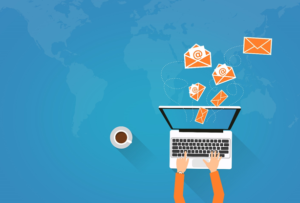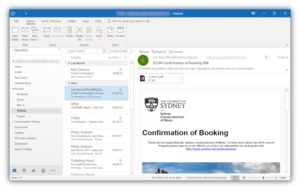1. You already have an email address
Not to state the obvious in the very first point, but it is true enough that it bears mentioning. Do you know anyone who doesn’t use email? I didn’t think so. Even my 85 year old grandma has it. In fact, it’s highly likely you have more than one email address, on more than one platform.
Every institution you become a member of, be it educational or corporate, one badge of membership is invariably an email address. You have one from your high school, your university, your job, one automatically provided for you by services like Facebook. The embarrassing one you created as a star-struck teen, addicted to Myspace and the latest Emo band. One you use to sign up for various sites and newsletters, but never check because you consider it your ‘spam’ account.
And this is not to mention your personal, ‘sensible’ address, perhaps one you’ve been using since you first connected to the Internet. Sure, many of these accounts have been left by the wayside, usernames and passwords forgotten, but the fact remains that the overwhelming majority of people have at least one active account. And this leads nicely to my next point:
2. The web is addicted to email
Email is the original web ID. Nearly every web based service requires you to sign up with an email address, or verify your new account via email. Email is used in customer support, engagement, service and marketing. Even networks with built in messaging platforms like Facebook and LinkedIn primarily use email to communicate with their users, generating billions of emails a day.
This is because email is also still the most successful online marketing tool. A Gigaom study naming it “the digital marketing workhorse” showed that email was often the single most effective tool in the marketing toolkit. Email came out on top of social network marketing, content & referral marketing, SEO and various forms of advertising in nearly all marketing goals, including customer retention, conversion, awareness and acquisition. The success of email in these areas meant that one quarter of the study respondents planned to increase the email marketing budget.
The web’s addiction to email doesn’t seem to be going anywhere any time soon.
3. Email is easy to use, and getting even easier
The process of filling out and sending an email is second nature to most. Most of you reading this post will have grown up with email. Very, very, few of us are like presidential hopeful Sen. Lindsey Graham who has allegedly never sent an email. Sure, websites exist that teach internet newbies how to use email, however once you have the basics in hand, the actual process of filling in the ‘To’, ‘Subject’, and body form is intuitive. You never even need look at the more complicated aspects like filing, tagging, and archiving if you don’t want to.
But what if you, like my grandma, really only want to deal with emails to or from your friends and family, and find the rest of it all a bit overwhelming? You’re in luck. Even emails that you’ve given permission to receive but nevertheless are a nuisance in your inbox – abovementioned marketing emails, newsletters, updates and the like – are getting easier to handle. Tools like Sanebox, Dropbox’s Mailbox, or Gmail’s Priority Inbox system make sure that only the most important messages land in your inbox. Other tools & apps aim to make email easier for consumers, marketers, and developers who want to create more of these tools (Nylas I’m looking at you).
We created an email infographic for this article! Click here to view.4. Email is naturally mobile friendly
Despite the ever growing field of communication apps, email is still one of the most pervasive forms of communication in the business world, according to the Radicati Group. In fact, recent statistics show that more than 50% of email is now opened on a mobile device. Email is inherently lightweight, and therefore easy to download, no matter how bad your internet connection. Nearly all mobile devices come with native and expertly built apps to manage email. And there are always new and better ways to do it: innovations like Google Inbox and Microsoft’s recently purchased Acompli are crowding the market with their ever easier-to-use email solutions.
The ability to render well across all devices is something most modern apps and websites can only strive for and rarely meet, and yet email manages this perfectly. Across an almost infinite number of devices, operating systems, browsers and apps, email generally works without any hiccups. Why is this? How has email kept up with the ever changing world of tech so brilliantly?
5. Email is an open standard protocol
Email is conveyed, stored and retrieved using the Simple Mail Transfer Protocol (SMTP), Post Office Protocol (POP), Internet Message Access Protocol (IMAP), and a bunch of other email protocols. Complicated, I know, but this essentially means that email is an ecosystem rather than a product. It is under the control of the Internet Engineering Taskforce, not some big corporation or brand new start up. It doesn’t belong to anyone, and is therefore free of the financial or political motives that can sometimes cloud the development of other tools. It is an open and free, albeit slightly outdated and complex, platform, upon which innovations have grown and flourished.
This crowd monitored platform means that developing a client to work with multiple email services can be a bit of a task, since each service can interpret the standards differently. (It explains why many of the tools listed in point 3 only work with one or two email clients). However, it also means that anyone can use any service they like, be it a personal server, Google’s free solution, or Microsoft’s enterprise software. And communication between these different services is close to flawless, because of this standard protocol.
It’s thanks to this open ecosystem that many tools lauded as the successors to email are, in fact, built upon its shoulders. Take Asana, one of many team productivity and collaboration tools, designed to get you to “stop working out of email”. Asana’s founder Dustin Moskovitz aims to prove to the world that email is on the out, and that tools like Asana will guide the communication of the future. The idea is that less email equals more and better work. However to sign up for Asana, you need to use an email address. You can then add an unlimited number of email accounts to your Asana profile. Asana makes email ‘manageable’ and more efficient (see point 3!). But it doesn’t remove the need for it.
Clearly, the end of email is nowhere near. The evolution of it continues.
6. Security: Spam volume isn’t as big of a deal as it used to be
According to SenderBase, Cisco’s real-time web and email threat intelligence reporting site, spam comprises 86% of all global email traffic. Originally considered the first sign of email’s inevitable demise, spam volume has actually become less of an issue than it used to be. ProofPoint found that the volume of spam actually decreased by 50% over 2014 (although spam did become more malicious over the same period).
Ever improving spam filters are fighting back against the tide, and I don’t know about you, but it is a rare day that any spam lands in my main inbox. With new anti spam legislation popping up the world over, and websites & software tools dedicated to helping users tackle the task, email spam rarely hits its target.
Email shouldn’t be getting all the flack for this anyway. Spam now on flourishes on many other communication platforms: an estimated 10% of tweets are spam; Instagram had such a problem with spam that it deleted millions of accounts in a bid to remove it from the system.
7. A quick look at internet privacy
Despite the high profile news stories that show everyone from the government to your neighbor have access to your information online, email is, believe it or not, one of the last bastions of web privacy. Sure, email is like a postcard when it comes to how easily it can be read, but there are ways to deal with this for the more tech savvy user.
There are several email encryption services available for those who are interested. Some are better than others, and some are so good that they still cause problems for the NSA. It seems that even old encryption services like PGP (or Pretty Good Privacy) can still stump government spies. If you want to be truly anonymous, using the Tor Browser to access the Tor network protects the transport of data and withholds some information about your computer, making it even more difficult for would-be spies to access your information.
A more lay approach to email (and web) privacy would be to be ‘smart’ about internet use. Set up multiple email accounts, don’t include sensitive information in emails (social security numbers, identification numbers, full names etc), be aware of current spam activity, create different strong passwords for all accounts, and much more.
The evolution of email is gradual and sometimes hard to see, but pretty significant nonetheless. Now I’m not such a Luddite that I don’t understand where the burgeoning communications market is headed. One day, someone somewhere will create a system that will totally replace it. Or maybe we’ll see a new set of protocols updated for modern users. But for now, the old school king of communication is here to stay.



Excellent article, Siobhan! The email may be old, but it’s definitely relevant, even in the current circumstances with all the social media platforms available, because it’s direct and personalized. Thanks, Niraj ( Founder at grexit.com)
Great article! It’s precisely because email is so old that it’s not going anywhere. You said it yourself, everyone has an email address, even my grandparents!
What’s more it makes sense to everyone, you tell them it’s just like sending a letter and they understand.
You have remember outside of the tech elite with Twitter, Snapchat, Periscope etc email is the workhorse of the Internet.